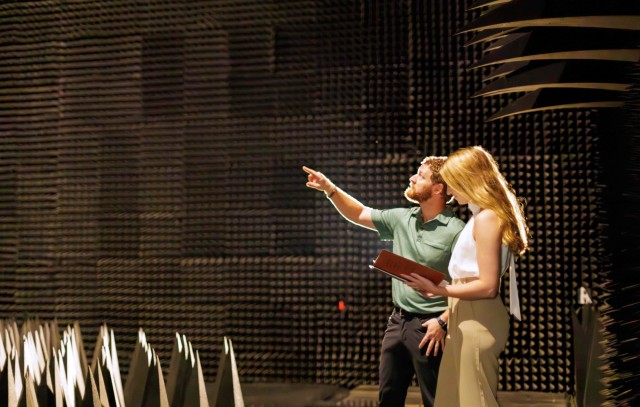
REDSTONE ARSENAL, Ala. (March 12, 2025) – It is a part of Redstone Arsenal history, but still plays a pivotal role in testing the next generation of missile technology.
The Radio Frequency Simulation System, or RFSS, is commemorating 50 years in service to the U.S. Army Combat Capabilities Development Command Aviation & Missile Center. It is a hardware-in-the-loop, closed-loop simulation facility, incorporating actual missile hardware within a real-time simulation environment to test how well the missile system works against its intended target. For decades, the RFSS has tested missile system performance for not just the U.S. Department of Defense, but also its NATO partners.
When one enters the chamber, they will immediately notice an unnatural silence. That is by design, as anechoic translates to, “without echo.” An anechoic chamber eliminates the reflection and noise caused by electromagnetic waves. What they will also notice are cones that look like spikes from every direction. Those cones are made of electromagnetic wave absorbing foam, but this isn’t the foam that you would find at an indoor trampoline park, this foam is filled with carbon material. It’s not a good idea to touch it.
“The black anechoic material in the chamber is loaded with carbon to aid in electromagnetic energy absorption,” said David Beck, subject matter expert for the RFSS. “Don’t brush against it, or your clothes will end up black too.”
What benefits does the RFSS provide? How does it measure up to an actual flight test, the “gold standard” of testing?
“The best way to know if something works is to take it out in the field,” said Ryan Brindley, strategic systems branch chief. “If I can get the enemy to cooperate in a controlled way and allow me to test my system against them in an actual battlefield environment that's great information. You're never going to have that happen. So, the next thing you can do is set up a flight test, but there's always going to be aspects of the system that you're not going to be able to test because maybe they're a little difficult to orchestrate.”
Orchestrating those aspects is where the RFSS comes in. Flight tests are expensive, and while the facility is not inexpensive itself, simulation testing gives the teams of engineers more than just one shot at success. It also gives them an opportunity to grow the technology – conceptualize new capabilities, a trial and error that would be impossible to do on a range.
The key is to ensure that the system feels like it is in the real world, Beck said, by generating various signals that make the environment more accurate.
“We have to do the calculations fast enough that the missile cannot differentiate between the simulation and reality.”
The RFSS simulation includes a six degree of freedom model which calculates how the missile moves throughout a simulated flight – which some would say is essential in simulation testing.
For the team who works in the chamber, it is a highly specialized field. It’s on-the-job training and as such, faces the same predicament that many of those fields do: building the bench. And as members of their team retire, they are looking for the next generation to take the RFSS into the future.
“It is very interesting, very unique work – a unique mix of hardware and software,” said Beck with a laugh. “I certainly did not learn this in school.”
--
The DEVCOM Aviation & Missile Center, headquartered at Redstone Arsenal, Alabama, is the Army’s research and development focal point for advanced technology in aviation and missile systems. It is part of the U.S. Army Combat Capabilities Development Command (DEVCOM), a major subordinate command of the U.S. Army Futures Command. AvMC is responsible for delivering collaborative and innovative aviation and missile capabilities for responsive and cost-effective research, development and life cycle engineering solutions, as required by the Army’s strategic priorities and support to its Cross-Functional Teams.

Social Sharing